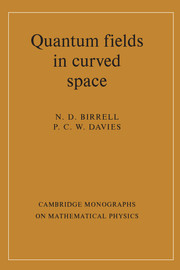Book contents
- Frontmatter
- Contents
- Preface
- Preface to the paperback edition
- Conventions and abbreviations
- 1 Introduction
- 2 Quantum field theory in Minkowski space
- 3 Quantum field theory in curved spacetime
- 4 Flat spacetime examples
- 5 Curved spacetime examples
- 6 Stress-tensor renormalization
- 7 Applications of renormalization techniques
- 8 Quantum black holes
- 9 Interacting fields
- References
- Index
6 - Stress-tensor renormalization
Published online by Cambridge University Press: 05 August 2012
- Frontmatter
- Contents
- Preface
- Preface to the paperback edition
- Conventions and abbreviations
- 1 Introduction
- 2 Quantum field theory in Minkowski space
- 3 Quantum field theory in curved spacetime
- 4 Flat spacetime examples
- 5 Curved spacetime examples
- 6 Stress-tensor renormalization
- 7 Applications of renormalization techniques
- 8 Quantum black holes
- 9 Interacting fields
- References
- Index
Summary
In previous chapters the production of quanta by a changing gravitational field was studied in detail. It was pointed out that only in exceptional circumstances does the particle concept in curved space quantum field theory correspond closely to the intuitive physical picture of a subatomic particle. In general, no natural definition of particle exists, and particle detectors will respond in a variety of ways that bear no simple relation to the usual conception of the quantity of matter present.
For some purposes it is advantageous to study the expectation values of other observables. Part of the problem with the particle concept concerns the fact that it is defined globally, in terms of field modes, and so is sensitive to the large scale structure of spacetime. In contrast, physical detectors are at least quasi-local in nature. It therefore seems worthwhile to investigate physical quantities that are defined locally, i.e., at a spacetime point, rather than globally. One such object of interest is the stress–energy–momentum (or stress) tensor, Tµν(x), at the point x. In addition to describing part of the physical structure of the quantum field at x, the stress-tensor also acts as the source of gravity in Einstein's field equation. It therefore plays an important part in any attempt to model a self-consistent dynamics involving the gravitational field coupled to the quantum field. For many investigators, especially astrophysicists, it is this back-reaction of the quantum processes on the background geometry that is of primary interest.
Information
- Type
- Chapter
- Information
- Quantum Fields in Curved Space , pp. 150 - 224Publisher: Cambridge University PressPrint publication year: 1982
